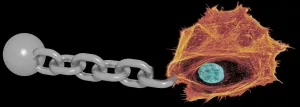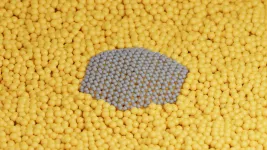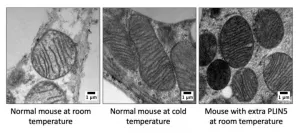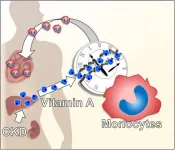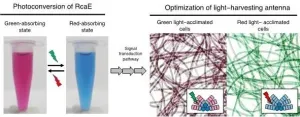(Press-News.org) The first evidence of a genetic link explaining why some people who catch Covid-19 don't become sick has been discovered
A scientific and medical team led by Newcastle University, UK, has demonstrated that the gene, HLA-DRB1*04:01, is found three times as often in people who are asymptomatic. This suggests that people with this gene have some level of protection from severe Covid.
The study, funded by Innovate UK, the UK's innovation agency, compared asymptomatic people to patients from the same community who developed severe Covid but had no underlying illnesses, and is published in the HLA journal.
The study team believe this is the first clear evidence of genetic resistance because this study compared severely affected people with an asymptomatic COVID group and used next generation sequencing to focus in detail and at scale on the HLA genes which are packed together on chromosome 6. Other studies have scanned the whole genome but that approach is less effective in the tissue typing complex.
Genome wide studies can be likened to a satellite image. The high density and complexity of the histocompatibility complex and variation in different populations means significant variation can be overlooked. For example, different alleles or versions of the same gene could have opposite effects on the immune response. This study was much more focused and compared symptomatic to asymptomatic in the same population revealing the "protective" qualities of the allele.
It is known that the human leukocyte antigen gene identified, HLA-DRB1*04:01, is directly correlated to latitude and longitude. This means more people in the North and West of Europe are likely to have this gene.
This suggests that populations of European descent will be more likely to remain asymptomatic but still transmit the disease to susceptible populations.
Dr Carlos Echevarria from the Translational and Clinical Research Institute, Newcastle University who also works as a Respiratory Consultant in the Newcastle Hospitals NHS Foundation Trust and is a co-author of the paper says: "This is an important finding as it may explain why some people catch Covid but don't get sick.
"It could lead us to a genetic test which may indicate who we need to prioritise for future vaccinations."
"At a population level, this is important for us to know because when we have lots of people who are resistant, so they catch Covid but don't show symptoms, then they risk spreading the virus while asymptomatic."
The effect of genes being linked to geolocation is an accepted scientific concept and it is well known that HLA genes develop over generations in reaction to disease-causing pathogens.
Study author, David Langton, whose company ExplantLab helped fund the study through an Innovate UK research award, added: "Some of the most interesting findings were the relationships between longitude and latitude and HLA gene frequency. It has long been known that the incidence of multiple sclerosis increases with increasing latitude. This has been put down in part to reduced UV exposure and therefore lower vitamin D levels. We weren't aware, however, that one of the main risk genes for MS, that is DRB1*15:01, directly correlates to latitude.
"This highlights the complex interaction between environment, genetics and disease. We know some HLA genes are vitamin D responsive, and that low vitamin D levels are a risk factor for severe COVID and we are doing further work in this area."
The study used samples from 49 patients with severe Covid who had been hospitalised with respiratory failure, samples from an asymptomatic group of 69 hospital workers who had tested positive through routine blood antibody testing and a control group from a study into the relationship between HLA genotypes and the outcomes of joint replacement surgery.
The research used next generation sequencing machines to study the different versions, or alleles, of the HLA genes in depth which was combined with a variety of expertise and modelling. The work was limited to samples from North East England during the first lockdown, this reduced variation in the study groups but more studies will be needed in the UK and other populations as there may be different copies of the HLA genes providing resistance in other populations.
INFORMATION:
The work was a collaboration between Newcastle University, Newcastle Hospitals NHS Foundation Trust, Northumbria Healthcare NHS Foundation Trust as well as the James Cook University Hospital and North Tees and Hartlepool Hospitals NHS Foundation Trust.
Co-author, Professor Sir John Burn, Professor of Clinical Genetics at Newcastle University said: "SARS Cov-2 is one of the greatest threats Mankind has faced. The more we understand why some people become sick, the better we can defend ourselves against this virus and others like it in future."
REFERENCE: The influence of HLA genotype on the severity of covid-19 infection, Carlos Echevarria et al, HLA.
https://onlinelibrary.wiley.com/doi/abs/10.1111/tan.14284
They recently published their findings in the renowned journal "Advanced Materials". Cells are not only our biological building blocks, but also highly dynamic, active systems. The research group led by Professor Käs has succeeded in significantly reducing these dynamics with heavy water, without damaging the cells.
"Generally, a lot of people know heavy water for its important technical use in nuclear power plants. We took a different approach here and were able to show that for cells, time - or, more specifically, their dynamics - can be significantly slowed down in the presence of heavy ...
Graphene may be among the most exciting scientific discoveries of the last century. While it is strikingly familiar to us--graphene is considered an allotrope of carbon, meaning that it essentially the same substance as graphite but in a different atomic structure--graphene also opened up a new world of possibilities for designing and building new technologies.
The material is two-dimensional, meaning that each "sheet" of graphene is only 1 atom thick, but its bonds make it as strong as some of the world's hardest metal alloys while remaining lightweight and flexible. This valuable, unique mix of properties have piqued the interest of scientists from a wide range of fields, leading to research in using graphene for next-generation ...
Engaged listening techniques such as eye contact, nodding and using key words to praise openness helps teenagers when they admit bad behaviour and share hurt feelings with their parents, a new study has shown.
University of Reading and Haifa researchers asked 1001 13 to 16-year-olds to watch a staged conversation between a parent and teenager about a difficult situation, with the parent adopting different body language and listening behaviour in different versions.
The participants who watched the versions where the parent was visibly attentive stated that they would have felt better about themselves as the teenager and would be more likely to open up about their ...
Water is weird - and yet so important. In fact, it is one of the most unusual molecules on Earth. It boils at a temperature it shouldn't. It expands and floats when it is in the solid-state. Its surface tension is higher than it should be. Now, new research published in the journal Nature has added one other equally strange property to water's list of oddities. The implications of this new revelation could have a remarkable impact on all water-related processes from water purification to drug manufacturing.
Stephen Cronin, professor of electrical and computer engineering at USC Viterbi School of Engineering, ...
Cancer researchers say they have established a new, life-extending treatment option for men with prostate cancer that has spread and become resistant to hormone therapy. The injected treatment combines a targeting compound with a radioactive isotope to irradiate and kill cancer cells.
An international clinical trial sponsored by Endocyte, Inc., a Novartis company tested the targeted radioligand therapy in study participants with advanced prostate cancer. All subjects had cancers that had spread to other organs and continued to progress after previous treatment with two kinds of drugs, androgen axis inhibitors and taxanes. The experimental treatment significantly extended survival, delayed ...
Leesburg, VA, June 4, 2021--According to a pilot study published in ARRS' American Journal of Roentgenology (AJR), the flexed elbow valgus external rotation (FEVER) view can improve MRI evaluation of the ulnar collateral ligament (UCL) in Major League Baseball (MLB) pitchers.
"The increased joint space width confirms elbow valgus stress with FEVER view," wrote corresponding author Thomas Knoblauch at the University of Nevada Las Vegas. "Diagnostic confidence increased, and additional UCLs were identified as abnormal."
Due to repetitive extreme valgus stress during overhead throwing maneuvers, UCL injuries remain common in throwing athletes. Because standard positioning for elbow MRI ...
DALLAS - June 4, 2021 - Increasing a protein concentrated in brown fat appears to lower blood sugar, promote insulin sensitivity, and protect against fatty liver disease by remodeling white fat to a healthier state, a new study led by UT Southwestern scientists suggests. The END ...
Fukuoka, Japan--According to the Global Burden of Disease Study 2017, close to nine percent of the global population lives with some form of chronic kidney disease, or CKD. Not only does the condition affect renal function, CKD has long been associated with increased risk of cardiovascular disease.
Now, in a new study that could aid the development of therapeutic drugs to reduce these cardiac complications, researchers led by Kyushu University have found an underlying molecular pathway that can explain how chronic kidney disease induces heart failure.
Studying mice, the researchers found that a key driver is the dysfunction of a type of white blood cell called a ...
Overview:
Certain cyanobacteria can change the absorbing light colors for photosynthesis using a green- and red-light sensing photosensor protein. A Japanese research group elucidated the molecular structure of RcaE, a representative member of the photosensors. They revealed the unique conformation of the bilin chromophore and the unique protein structure that potentially functions as a proton transfer route to bilin. They also demonstrated that RcaE undergoes protonation and deprotonation of the bilin chromophore during the green and red photoconversion. These results provide insights into how cyanobacteria evolved photosensors with diverse spectral sensitivities and contribute to the development of new photoswitches of ...
Coral insights into 1,000 years of seasonal changes in the Arabian Sea warn of significant impacts caused by global warming.
Every year, the southwesterly winds of the summer monsoon sweep down the Arabian Peninsula, pushing the surface waters of the Arabian Sea away from the coast and driving an upwelling of deep waters to the surface. This rising seawater is colder and less saline than the surface water and is rich in nutrients, providing energy for the various organisms living in the Arabian Sea and Indian Ocean.
Scientists from Japan, Taiwan and Germany, including coral reef scientist Dr. Tsuyoshi Watanabe of Hokkaido University, have uncovered evidence from corals off the coast of Oman suggesting that global warming is causing changes to the Arabian Sea that could impact the ...

